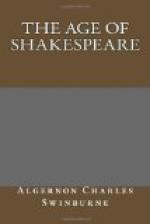Peele, George, 69, 205.
Percy Society, 188.
“Persae,” the, 81.
Persius, Tourneur akin to, 281.
“Phoenix and Turtle, The,” 138, 156.
Pickwick Papers, 100.
Plautus, imitated by Dryden, Moliere, Rotrou, 216;
model for Heywood, 231, 240.
Plymouth, 243.
“Poetaster, The” (Jonson), 68, 133, 138.
Ponsard, 38.
Pope, 82, 228.
“Prince Nicander’s vein,” 223
Protestant animosity in drama, 207.
Prynne, William, 207.
Psyche, subject of English poetry, 222, 223, 251.
“Puritan, The,” 181.
Puritanism, 241, 278, 281, 286 note.
“Pygmalion’s Image,” 136.
Queen Elizabeth, 69, 105, 168, 211-213, 256.
“Queen of Corinth, The,” 178.
Quevedo, 95.
Rabelais, 95; Rowley compared with, 190.
Raleigh, Sir Walter, 69.
Rand, verb, 189.
“Rape of Lucrece, The,” 223.
“Raven’s Almanack, The” (Dekker), 103.
Realism, in dialogue, 194;
of Heywood and Fletcher, 214, 247;
differentiated from romanticism, 234.
“Rehearsal, The,” 226.
Renascence, 281.
Restoration, the, 157 note, 259, 278.
“Return from Parnassus, The,” 141.
“Revenger’s Tragedy, The” (Tourneur), 176, 268, 273, 287.
“Roaring Girl, The,” 161.
“Robert, Earl of Huntington,” 73.
Rochester, Lord, 157.
“Rod for Runaways, A” (Dekker), 103.
“Romeo and Juliet,” 69, 179, 247.
Rotrou, 216.
Rowley, William (187-199), genius in comedy and tragedy,
24, 166-168;
collaboration with Middleton, 161, 179,
181-183;
compared with Dekker and Nash, 188;
akin to Rabelais, 190;
comic style compared with Dekker, Middleton,
Heywood, 191;
theory of verse, 194;
best as tragic poet, 196, 197;
compared with Heywood, 244.
“Royal King and Loyal Subject, The,” 193, 232.
St. George’s Day, 190.
“St. Patrick for Ireland” (Shirley), 194.
“Samson Agonistes,” 157.
Sancho Panza, 229.
“Sardanapalus,” 267.
“Satiromastix” (Dekker), 69, 127, 128.
Scott, Sir Walter, 84;
on Middleton, 153.
“Seaman, The,” 96.
“Search for Money, A,” 188.
“Second Maiden’s Tragedy, The,” 174.
“Sejanus,” 144.
Selden, 163.
Settle, Elkanah, 157 note.
“Seven Deadly Sins of London, The,” 93.
Shadwell, 251, 267.




